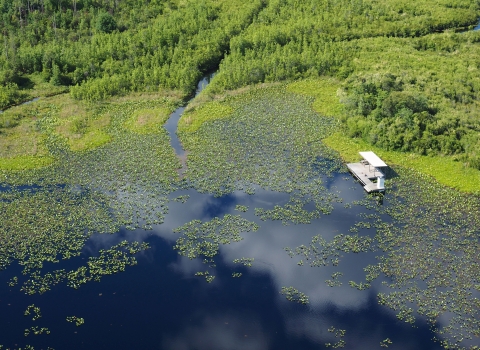Ventura, Calif. - Two plants that live on California’s Channel Islands and nowhere else on earth – the Santa Cruz Island dudleya and island bedstraw – have reached recovery thanks to Endangered Species Act (ESA) protections. The U.S. Fish and Wildlife Service is proposing to remove these two plants from the Federal List of Endangered and Threatened Species.
“The recovery of these island plants is the result of long-term cooperation and conservation efforts by scientists and land managers,” said Paul Souza, director of the Service’s Pacific Southwest Region. “That’s what the ESA can bring to the table – attention, resources, and incentive for sustained conservation work that produces meaningful results.”
Scientists say their understanding of the plants’ ecology, habitat needs, and status has improved due to the diligent efforts of the U.S. Geological Survey, The Nature Conservancy, National Park Service, and Santa Barbara Botanic Garden to survey, study, and conserve habitat on Santa Cruz Island and San Miguel Island, two of California’s northern Channel Islands.
“Plants are key contributors to the overall food web and island ecosystem,” said Ken Niessen, Service botanist. “As the cause of their decline, and now as their caretakers, people have a responsibility to ensure the plants, and the benefits they provide to their ecosystem, are not lost to extinction.”
In 1997, the Service determined 13 plants on California’s northern Channel Islands needed ESA protections as a result of decades of habitat loss and alteration due to sheep grazing, and soil loss caused by rooting of non-native feral pigs. By 2000, sheep grazing ended, and by 2006, all non-native feral pigs had been removed from the islands. In 2000, the Service worked with botanists and land managers to publish a recovery plan that would guide future recovery efforts for the imperiled plants.
“Studies tracking the areas occupied by these plants before, during and after animal removal show that remarkable recovery can happen when conservation actions are taken,” said Kathryn McEachern, research ecologist with the U.S. Geological Survey. “USGS research shows that populations of both species have expanded beyond their boundaries since we started mapping them in 1998.”
Island bedstraw (Galium buxifolium) is a long-lived woody shrub with small flowers that lives on coastal bluffs, steep rocky slopes, sea-cliffs, and occasionally pine forests, of Santa Cruz and San Miguel Islands. At the time of listing, population estimates were in the hundreds. Helicopter surveys from 2017 estimate more than 15,000 individual plants now occur on the islands.
McEachern says bedstraw research, in particular, shows that new plants are establishing, which provides evidence of potential for continued population growth as the young plants mature and produce seeds. “These are signs that these species are on recovery trajectories, rather than on a downward spiral that leads to extinction,” she said.
The Santa Cruz Island dudleya (Dudleya nesiotica) is a flowering succulent perennial that lives on the marine terraces of Santa Cruz Island. Scientists say after its initial recovery the population has remained relatively stable over the last 25 years, with current estimates around 120,000 individuals. Santa Cruz Island is collaboratively managed by The Nature Conservancy and Channel Islands National Park as a single biological unit.
“Today we get to celebrate the recovery of these two species no longer faced with the imminent threat of extinction, and tomorrow we will be back in the field for those plants that still need a helping hand,” said John Knapp, senior scientist with The Nature Conservancy.
“All visitors to the islands can be part of the success by staying on established trails and roads to protect vulnerable populations. Recovery doesn’t happen overnight. It takes sound science, collaboration with many partners, and most importantly commitment.”
“The delisting of these species represents another victory for conservation as park staff and partners continue to work tirelessly at conserving and restoring the five islands,” said Ethan McKinley, superintendent of Channel Islands National Park. “Recovery of native plants is an integral part of preserving the park for current and future generations.”
Post-delisting monitoring plans have been developed to monitor the plants’ status to verify that the species remain secure from risk of extinction. The Service will accept public comments on the proposed rule and post-delisting monitoring plans from December 1, 2022 to January 30, 2023.
To learn more about the history of island plants on the northern Channel Islands, visit “Restoring Rare Plants on California’s Channel Islands,” an interactive StoryMap developed by the U.S. Fish and Wildlife Service in collaboration with Kendra Chan Directorate Fellow Daniel Cisneros.
Working with others is essential to protecting ecosystems that benefit society as a whole. The Service regularly engages conservation partners, the public, landowners, government agencies, and other stakeholders in our ongoing effort to identify innovative strategies for conserving and recovering protected wildlife, plants, and their habitats.







